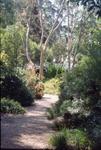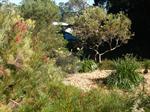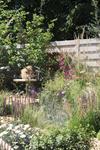
Design Natural Gardens, Bush Gardens, Sustainable Landscapes.
- Learn to design all types of natural gardens
- Develop your ability to design a bush garden (totally native, or using a mixture of both indigenous and other plants).
- Start a business, get a job, or learn to create a great garden for your own property
- 100 hr, self paced course, for landscape professionals or students training to work in landscaping.
"Natural Gardens are popular both because they can require less maintenance, and because they create a more "relaxed" ambiance. It today's fast paced world; the natural garden has become very popular. This course shows you how to create all types of natural gardens, from woodlands and rain forests, to xerophytic landscapes. Over more than 20 years, I've seen many a person take this course, and go on to a very successful career in landscaping" -John Mason Dip.Hort.Sc. FAIH, FIOH, FPLA, garden author and landscape magazine editor, garden designer and principal of ACS.
Lesson Structure
There are 8 lessons in this course:
- Introduction to Natural Gardens.
- History of Natural Gardens
- Developing Concept Plans
- Plants for Natural Gardens
- Planting Design in Natural Gardens
- Natural Garden Features
- Natural Gardens Today
- Bringing It All Together.
Each lesson culminates in an assignment which is submitted to the school, marked by the school's tutors and returned to you with any relevant suggestions, comments, and if necessary, extra reading.
Aims
- Explain the concept of natural gardens.
- Prepare concept plans for different natural gardens.
- Plan the incorporation of appropriate plants into a natural garden design.
- Plan the appropriate incorporation of non-living landscape features in a natural garden.
- Produce detailed plans for a natural garden.
What You Will Do
- Explain the historical development of natural garden design, in your locality.
- Analyse plant inter-relationships within a specific natural environment (e.g. an area of bushland).
- Analyse the design of three natural gardens, in an essay illustrated with photographs or sketches.
- Explain, using illustrations, concepts of landscape design, showing their relevance to natural garden design, including:
- Unity
- Balance
- Proportion
- Harmony
- Contrast
- Rhythm
- Line
- Form
- Mass
- Space
- Texture
- Colour
- Tone.
- Develop three alternative natural garden concept plans for the same specified site.
- Collect pre-planning information for a site for a proposed natural garden, by conducting a site survey, and interviewing a prospective client.
- Explain, through a sequence of illustrations, a logical process of developing a design for a natural garden, on a specific site surveyed by you.
- Prepare concept plans for two small natural gardens, including: *A rain forest garden *A sclerophyll garden.
- List fifty different plants suitable for use in a natural garden design, of a specific style on a specified site, in your locality.
- Explain compatibility considerations, when selecting different plants to include in the same natural garden design.
- Develop a nursery customer information sheet, to provide guidelines for planting design of a natural garden.
- Prepare a plant collection of fifty relevant plants, which includes:
- A photo, drawing or pressed specimen of each plant
- Plant names (scientific and common)
- Cultural details
- Uses/applications in garden design.
- Prepare planting designs for three different styles of low maintenance garden beds, between 30 and 60 square meters each in size, and using only Australian Native plants.
- Explain design options for six different landscape features in a natural garden, including:
- Rockeries
- Patios
- Water features
- Paths.
- Describe the characteristics, including:
- Cost
- Availability
- Longevity
- Appearance
- Maintenance, of ten different landscape materials, suited for use in a natural garden design.
- Design a water feature for a natural garden, incorporating:
- Concept drawings
- Materials list
- Cost estimates
- Guidelines for construction.
- Explain, using illustrations, the structural design of a masonry garden wall.
- Explain, using illustrations, different appropriate applications for timber structures in a natural garden design.
- Prepare plans, including structural diagrams and materials lists, for the construction of three different landscape features, which are appropriate for inclusion in a natural garden.
- Develop a design "Brief" for a natural garden, in consultation with a client, through an interview and site inspection.
- Design a natural garden of 200 to 500 square metres, including:
- A landscape plan drawn on tracing paper, or an electronic file
- Materials specifications, including types and quantities, to suit a site surveyed by you, and emphasising one type of plant, such as ferns, wildflowers or sclerophyl type plants.
- Prepare a detailed professional standard plan for a natural garden of 500 to 2000 square metres, to an acceptable industry standard for a professional garden designer, which includes:
- A landscape plan
- Materials specifications, including types and quantities.
- Explain the purpose behind decisions made by you in a natural garden designed by you.
WHAT IS A NATURAL GARDEN?
Broadly speaking, a natural garden is one that appears to be a relatively natural occurrence: not contrived or planned by man, and not maintained with any substantial input by man. Although natural gardens may, in fact, be planned, and may require routine maintenance; it is just these things are not obvious. A natural garden frequently makes use of the indigenous flora, or native plants of a particular area. It might make use of other plants as well. Your choice of plants for a natural garden will largely depend upon what affect you are trying to achieve.
To appear informal a natural garden should have curves rather than being angular; is informal rather than formal and tends to incorporate nature rather than manipulate it.
Problems arise with the definitions of ‘nature’ and ‘native’. Native plants have been defined as being anything from local or regional to national and even continental. The terms indigenous or endemic should be used with care, as they are generally regarded as “scientific” terms.
In the United States there is also debate as to what should be deemed native from a historical context. Some would argue that only plants which date back to prior to the original European settlement of 1492 should be labelled native. Others have suggested that any plants that have been there for 200 years should be considered native. The term ‘naturalised’ may be used for plants which are not truly native, but have been long-established in a country or area: e.g. 70 species of Eucalypt, (native trees from different parts of Australia), are found in Cyprus but only a very few - perhaps 6 species - have recorded there for sufficiently long periods to be regarded as ‘naturalised’ and thus included in the native flora.
Definitions of terms:
Native: originating in a specific place – eg. kangaroos are native to Australia (Collins English Dictionary 1979 edition)
Natural: existing in or produced by nature (Collins English Dictionary 1979 edition)
Indigenous: originating or occurring naturally, not imported (Collins English Dictionary 1979 edition)
Endemic: present within a localised area (Collins English Dictionary 1979 edition): a plant that is confined to a certain limited area; for example Cedrus libani subsp. brevifolia is found only on the island of Cyprus – it is endemic to the island.
The term ‘nature’ has been applied to natural gardens with no less ambiguity. Given that nature is a construct created by man, what is included within nature is perhaps best considered in relation to social, cultural, political and aesthetic influences of the period in history and the country.
Natural gardens can take on many different forms within the same country since there can be a vast array of flora and fauna and different natural landscapes.
WHAT IS A NATURAL, WILD OR BUSH GARDEN?
The term Bush Garden is widely used in Australia and in Africa; the term Wild Garden is most often used elsewhere in the world.
Essentially a bush garden is a type of natural garden which is informal in style and attempts to recreate the appearance of a natural or bush area. Strictly speaking, a bush garden should use combinations of plants which occur together in the natural landscape. In other areas of the world, the term wild garden will reflect the same concepts.
For example, in Australia a Eucalypt which occurs naturally close to Sydney should not be planted alongside a Banksia which is exclusively native to Western Australia.
In Britain, a Vaccinium myrtillus (bilberry or whortle berry), which is common on the northern moors of England, should not be planted alongside Vaccinium microcarpum (small cranberry) which is limited to bogs in central Scotland.
In reality, it is common to mix plants which do not come from the same area in natural, bush and wild gardens. For example, Papaver rhoeas (field poppy/Flanders poppy) is now naturalised virtually all over the world although it originates from the Central Asia. This will create a wilderness atmosphere. A natural garden can have Chinese, European, American and Australian plants, all together; however, such a garden is more difficult to create than one which copies the plant associations which occur in nature.
When plants are combined in the way in which they occur naturally, it is reasonable to assume that none of them will compete with each other too strongly (i.e. they should grow in harmony and not choke each other out of existence). When plants which do not occur naturally together, are planted together, it is possible that some will be much stronger growing varieties than others, and that some will gradually gain dominance, while others will find it harder to compete and eventually disappear.
In the United States the best example of a naturalistic style is the prairie. Much of the original prairie has disappeared, but now parts of it are being restored to its original beauty. The prairie may be considered to be somewhat similar to the native bush-land in Australia.
Jensen (see next lesson) created naturalistic gardens with a regional mid-western flavour. There are some excellent examples of his work in the book ‘Recovering the Prairie: ed. Robert F. Sayre (University of Wisconsin Press).
ENROL AND LEARN TO DESIGN AND CREATE NATURAL GARDENS